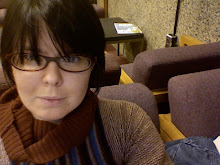The days keep running away from me. It's a small walk from school to here, and so many days I find that I want to go in a different direction, and my path doesn't wind back this way. Today, though, I had lunch in my little caffe (Caffe Sabatino) on via Faenza, so this is on my way home.
I went to Capella Brancacci today, to see the frescoes of Masaccio and Masolino, which I studied at university last year. We used the chapel to discuss ideas about restoration, and the presentation of works: the chapel was restored during the 1980s, and right until the end the work proceeded without controversy. Then, just before the chapel reopened, the Baroque altarpiece which had been in the chapel before its restoration was put back, and suddenly there was an uproar: because the altarpiece was considered only an "average" example of the Baroque style, while the earlier frescoes, especially the work of Masaccio, are considered incredibly important to the history of painting: the frescoes contain some of Masaccio's most important work (I believe he was one of these young chaps who died early), and Masaccio is considered the father of modern painting, because of his "discovery" of perspective. As with so many artists, before I came to Florence I had only seen reproductions of his work - of course the real life experience is so different. The reason there was the outcry over the altarpiece is that its restoration obscured parts of the frescoes. We discussed it at length in class last year. My tutor professed to continually wavering in her opinion about whether the right or wrong decision was made.
I suppose I wish the altarpiece hadn't been restored: while it is only a bottom corner of two of the frescoes that have been obscured, it becomes very awkward to get an overall sense of those pieces, because of the awkward angle you are forced to look at them from if you want to see the parts behind the altarpiece. My lecturer argued that as the chapel is an example of artwork in situ, and the context is religious, then the altarpiece should be there. But I disagree, because for well over a century the chapel existed without the altarpiece: so to restore it on that argument is simply to privelege one period of history over another period of history. Now the function of the chapel is essentially the same as a museum: visitors come to view the frescoes, and are bustled about so they don't have the chance to use the chapel for devotional purposes. Even if they did wish to pray, however, when it was possible for years before the altarpiece was installed to use the space for prayer, why is it impossible afterwards? I swayed my tutor a little with these arguments, but I think my lecturer was a little bit immoveable. Oh well.
I have been very excited about my Italian classes, because yesterday we began to learn the past tense. It will be a great help in translating my children's books. I'm thinking about making a start on Sylvia Plath's "Bed Book" tonight. I've read it, of course, in English, but not for a few years, and it's short enough that I think I'll be able to translate it more easily than the little Margaret Atwood book I'm VERY slowly making my way through. I also went looking for some Enid Blyton - I want to eventually be able to read The Famous Five (!) in Italian - but I guess she must be out of fashion, because I couldn't find any of her books anywhere here. I found Anne of Green Gables though - except here they call it Anne of the Red Hair.
Walked across Ponte Vecchio for the first time today. I was audacious and went into a few of the jewellery shops to look at their gold chains, as I bought a coral pendent on Corsica with a gold setting, but as I'm living very cheaply, a necklace from Ponte Vecchio will have to remain a dream, methinks.
An Australian poet in Washington, DC
Kate, Underground.

Kate Middleton is an Australian poet currently living in the US, studying hard and writing here when she has time. This is a space both to keep in touch, and to keep up with the world of poetry, poetics and other writerly encounters.
I can be contacted at katemid [at] gmail [dot] com
|
|
| Subscribe to misskateunderground |
| Visit this group |
Adventures Underground

About Me
Other tidbits
- A Tonalist Notes (Laura Moriarty)
- Adam Aitken
- Bill Emory
- Bits and Ends
- Davey Dreamnation (David Prater)
- Dumbfoundry
- I like the noise
- Ilya Kaminsky
- Independence Day Project
- Ivy is Here (Ivy Alvarez)
- Karolinka In & Around Bulgaria
- Kate Fagan
- Lulu Illustrated
- Matilda
- Matthew Thorburn
- Nomadics (Pierre Joris)
- Reading Your Favourites
- Ruby Street (Jill Jones)
- Silliman's Blog
- Szia Robyn!
- The Little Prophet
- The Little Workshop (Cassie Lewis)
- Theatre Notes (Alison Croggon)
Further Adventures Underground

My poems on the web
I like to read
Interesting organisations
Continued Adventures Underground

Presses
Labels
- actresses (1)
- australia (2)
- books (8)
- concerts (1)
- events (8)
- exhibitions (6)
- films (4)
- Fire Season (1)
- friends (1)
- independence day project notes (11)
- news (1)
- notebook (13)
- papers (2)
- people (4)
- performances (6)
- poetry (13)
- readings (17)
- reviews (2)
- sightseeing (1)
- status report (21)
- study (24)
- teaching (14)
- travel (13)
